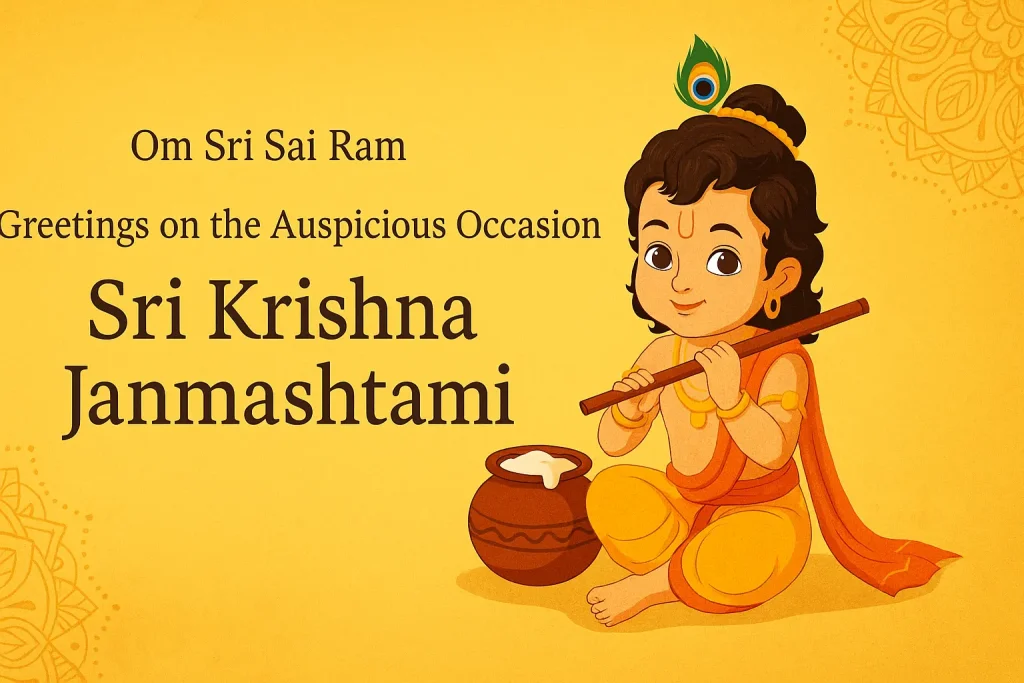
Greetings on the Auspicious Occasion of Sri Krishna Janmashtami
Let us celebrate the divine birth of Lord Sri Krishna by understanding the deeper significance of His advent and some lesser-known facts from His life.
The Divine Birth of Krishna: Timeless Significance
Krishna Janmashtami, more popularly known as the birthday of Lord Krishna, is celebrated with great devotion and joy across India, particularly during the monsoon month.
According to the Hindu calendar, this important day falls on the Ashtami (eighth day) of the Krishna Paksha in the month of Shravana.
- Date of Birth: Krishna was born on 20th July, 3228 BCE (Before Christ).
- Astrological Details: Sri Mukha year, Rohini nakshatra, at 3:00 AM.
- Place of Birth: A prison cell in Mathura (Dwapara Yuga) to Vasudeva and Devaki.
To protect Krishna from the tyrant Kamsa (his maternal uncle), Vasudeva carried the infant across the Yamuna river on a stormy night, delivering him to Nanda and Yashoda in Gokul, who became his foster parents.
This very moment also marks the beginning of Kali Yuga, referred to as Ugadi or the first day of this age.
Why Krishna Took Birth: The Purpose
The most widely accepted view is that Lord Krishna is the eighth incarnation of Lord Vishnu.
As per the Mahabharata:
- Krishna’s birth was destined to eliminate evil, especially Kamsa, and
- To restore dharma whenever there is imbalance in peace and prosperity.
Even as a child, Krishna’s divine qualities became evident—protecting people, spreading joy, and symbolizing divine love.
The Cultural Evolution of Janmashtami
- Nanda Maharaja was the first to celebrate Krishna’s birth with grandeur by distributing gifts and food among villagers.
- This tradition, known as Nandotsav, continues today—where wealthy devotees distribute food and clothes in the community.
- From Gokul and Mathura, the festival spread across Uttar Pradesh, and today, it is observed all over India and abroad.
Janmashtami celebrates faith, love, friendship, and peace—values that Krishna embodied.
Three Deeper Meanings of the Name ‘Krishna’
As explained by Bhagawan:
- Krishyati Iti Krishna – “The One Who Cultivates”
- Krishna cultivates the Hridaya Kshetra (field of the heart).
- He removes weeds of bad qualities, waters with love, ploughs with sadhana, and sows devotion.
- Krishna cultivates the Hridaya Kshetra (field of the heart).
- Karshati Iti Krishna – “The One Who Attracts”
- His eyes, speech, leelas, and presence attract all beings.
- His words calm even the most disturbed hearts.
- His eyes, speech, leelas, and presence attract all beings.
- Kushyati Iti Krishna – “The One Who is Blissful”
- Krishna is always immersed in bliss.
- Sage Garga, recognizing these divine traits, named Him Krishna.
- Krishna is always immersed in bliss.
While many know Krishna as the “dark one” in complexion, the deeper spiritual meanings far surpass the physical.
Essence of Krishna’s Life
“Krishna proclaimed the eternal truths, propagated dharma, and delighted the world with His divine leelas.”
— Bhagawan’s Discourse, August 14th, 1990
How to Celebrate Janmashtami: The Spiritual Way
Swami guides us:
“The Krishna whose advent you should celebrate is not just the cowherd boy with a flute,
but the indefinable divine principle born within you.”
- Mathura symbolizes the navel (origin), Devaki is divine energy.
- Gokul (mouth) and Yashoda (tongue) nurture the sweetness of divine name.
- Krishna is Atmic Consciousness, who should be fostered on the tongue through Namasmarana (chanting).
When Krishna dances on your tongue, as He did on Kalinga’s hoods, the poison of speech is expelled without harming others.
Traditions & Rituals of Janmashtami
- Temples are adorned with lights, garlands, and flowers.
- Devotees engage in bhajans, kirtans, dramas, and Krishna leela enactments.
- Children dress as little Krishnas and Radhas in schools and communities.
Dahi Handi
- Celebrated the day after Janmashtami.
- Represents Krishna’s childhood love for butter.
- A pot (handi) filled with butter, ghee, and dry fruits is hung high.
- Young men form a human pyramid to break the pot—symbolizing unity and Krishna’s mischief.
Global Devotion to Krishna
Today, not only Indians but also devotees across the globe celebrate Janmashtami with great enthusiasm.
- His Bhagavad Gita teachings guide humanity with deep philosophy.
- His childhood leelas captivate hearts with sweetness and innocence.
The True Offering: Live His Teachings
This Janmashtami, let us:
- Celebrate with devotion
- Reflect on Krishna’s divine qualities
- Practice love, discipline, and dharma
- Offer our actions at His Lotus Feet
“Krishna reciprocates the love and spirit with which He is worshipped and remembered.”
Adorn the deity with beautiful clothes, ornaments, and flowers, and offer bhoga with devotion.
Krishnarpanamastu
Everything is humbly offered to Lord Sri Krishna.





